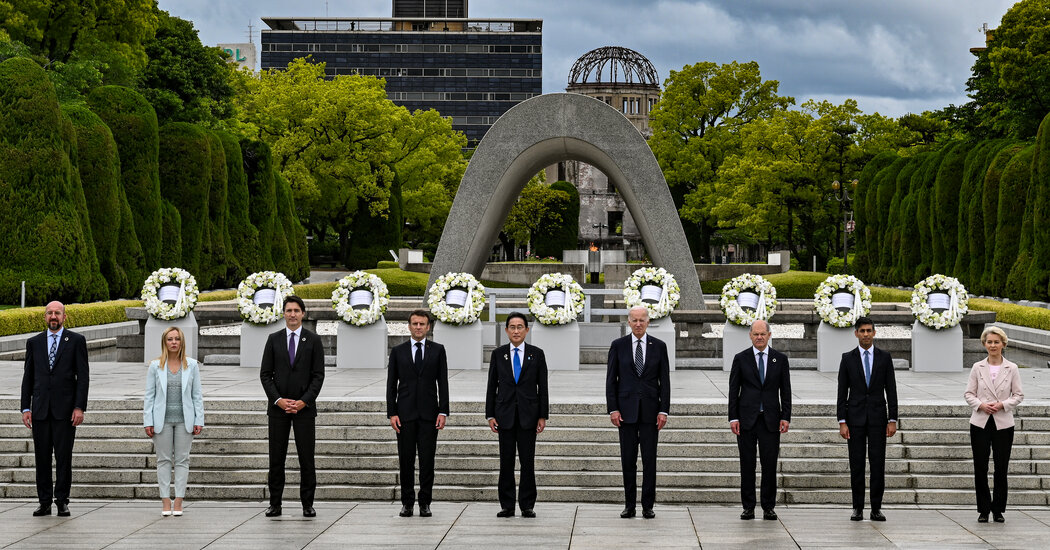President Biden was 2 years old when the nuclear era opened with a blast of devastation unlike any the world had ever seen. Seventy-eight years later, he came on Friday to ground zero of the first atomic bomb used in warfare to pay tribute to the dead.
Mr. Biden and other world leaders met privately with a survivor, toured a museum, laid wreaths at the Hiroshima Peace Memorial and planted a tree. The president stared solemnly at the Cenotaph for the Atomic Bomb Victims as the city’s mayor described the monument. But the president offered no comments on what he saw, much less the apology some Japanese still wish the United States would provide.
Mr. Biden’s visit came at a pivotal moment in the atomic age, with the “prospect of Armageddon,” as he has described it, greater than at any time since the Cuban Missile Crisis of 1962. President Vladimir V. Putin of Russia has hinted ominously that he may yet unleash nuclear weapons to salvage his flailing invasion of Ukraine. And rather than moving away from the kind of destruction represented by Hiroshima, the world is seeing more such arms being built and fewer constraints being imposed on their spread.
“I worry a lot that we are moving in the wrong direction, that we are less secure, and I worry we will see nuclear weapons used in our lifetimes,” said Jon B. Wolfsthal, a former arms control adviser to President Barack Obama and now a senior adviser to Global Zero, a group that advocates abolishing nuclear weapons. “So to me, the importance of going to Hiroshima is not just about the symbolism, but also using the legacy of Hiroshima to remind people that these weapons are devastating and should never again be used.”
The visit to the Hiroshima memorial served as a symbolic opener to this year’s Group of 7 summit meeting of major industrial democracies, where the war in Ukraine will be a major topic of discussion. Prime Minister Fumio Kishida of Japan, who is hosting the gathering and represents Hiroshima in Parliament, hoped to highlight efforts to rid the world of nuclear weapons
“Through their visit to the Peace Memorial Park, the G7 leaders deepened their understanding of the reality of the atomic bombings and joined their hearts in consoling the souls of lost lives,” the Japanese foreign ministry said in a statement. “The G7 leaders reiterated their position that threats by Russia of nuclear weapon use, let alone its use, are inadmissible.”
But there appeared to be no major new initiatives in the works to achieve that goal; if anything, nuclear proliferation has only escalated in recent years. Russia recently suspended its last major nuclear arms control treaty with the United States, the New START agreement that limited warheads and delivery systems. North Korea has expanded its own nuclear arsenal as diplomatic efforts to persuade it to reverse course have failed. Mr. Biden’s effort to revive Mr. Obama’s pact with Iran, intended to prevent it from developing nuclear weapons, has all but collapsed. And the Pentagon warns that China could more than double its nuclear arsenal, to 1,000 warheads, by 2030.
America’s mission to stem the spread of nuclear weapons has always been complicated by its own history of having introduced them to modern warfare. “The United States is the only country in the world that has twice used nuclear weapons, destroying the Japanese cities of Hiroshima and Nagasaki, and setting a precedent,” Mr. Putin said last fall while annexing eastern portions of Ukraine.
The matter has always been a delicate one in Japanese-American relations as well. Mr. Obama became the first sitting U.S. president to visit Hiroshima, in 2016, but he refused to apologize for the bombing, which could have provoked criticism back home among Americans citing the Japanese attack on Pearl Harbor that brought the United States into World War II.
Instead, Mr. Obama, who made global nuclear disarmament a long-term goal, sought to use his visit to outline his vision for “a future in which Hiroshima and Nagasaki are known not as the dawn of atomic warfare but as the start of our own moral awakening” — a notion that seems even further from reality seven years later.
A B-29 Superfortress named the Enola Gay dropped the atomic bomb, named Little Boy, on Hiroshima on Aug. 6, 1945. The blast generated heat close to 14,000 degrees Fahrenheit by one calculation and destroyed or damaged 60,000 of the city’s 90,000 buildings; an estimated 140,000 people died, most of them civilians. A second bomb was dropped three days later on Nagasaki. Within a week, Japan had announced that it would surrender, bringing an end to the deadliest war in human history.
Debate has raged ever since about President Harry S. Truman’s decision to use the newly developed weapon without a more explicit warning or a demonstration, a decision justified as the best way to force the military-dominated leadership in Tokyo to give up without forcing the United States to mount a bloody amphibious invasion of the home islands.
Hiroshima has long since been rebuilt into a vibrant city of 1.2 million and a manufacturing hub known for heavy industries, such as automobiles, steel and shipbuilding. Bustling shopping areas and lush, tree-filled parkland leave little sense of its legacy of death. The advance of time has left fewer hibakusha, as the survivors are known.
Daryl G. Kimball, executive director of the Arms Control Association, said that how that legacy can be translated into reducing the risk of a new Hiroshima “will be the most important legacy of this G7 summit” but will require active presidential engagement.
“Preventing arms racing, proliferation and nuclear war is a global endeavor,” Mr. Kimball said. “But history shows there is no substitute for U.S. leadership in reducing nuclear dangers, and there is no better time than now for President Biden outline his plan to renew nuclear risk reduction and disarmament diplomacy to move us back from the brink.”

Tinggalkan Balasan